- Kasba Peth is where Pune was born. Sandeep walks you through its history and culture. Pictures shall make you feel you actually visited.
Large cities
are often over run over by mindless urbanization compelled by the ever
increasing population and commercial interests. Pune is no exception to this
unfortunate trend. It is in this cacophony one also comes across oasis that
reflect a bygone era. It provides clues to the history of the rulers and also
the lives of the commoners. The faiths, traditions and crafts are preserved as
if the time machine has done its magic and taken us back in time.
The history of
the city of Pune has fascinated me since a long time. This affiliation with the
city has resulted in my exploration of the nooks and corners of the old city.
It is said that joy multiplies when shared with others. With this in mind I thus encouraged friends
to join me in this discovery. Their energy proved infectious and soon I found
myself leading curious and interested people through the by lanes of the city
to discover it’s past.
I have been
conducting these walks covering different parts of the city over the last few
years. Different parts of the city hold interest for varied reasons. For those
keen on the history and development of the city discovering the Kasba Peth area promises to be a treat.
This Peth or ward is the oldest part of the city and is where Pune was born and
blossomed over period of history. The barely one square kilometer area holds
great treasures from the past.
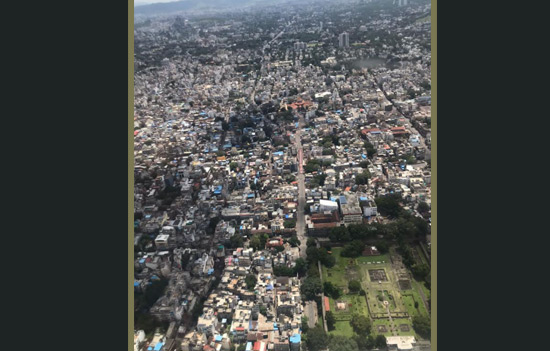 Pune
from air. Shaniwar Wada, Lal Mahal and Kasba Ganpati can be seen. Credits Nitin
Welde.
Pune
from air. Shaniwar Wada, Lal Mahal and Kasba Ganpati can be seen. Credits Nitin
Welde.The Kasba Peth
has been the silent witness to history, heritage, culture and faith of its
people and that of the city over different periods in history.
Pune was born as a bunch of a few small hamlets. Over a period in time these hamlets merged into a small town called 'Kasbe Pune'. Since the era that Pune was born, this locality has been continuously inhabited for at-least a thousand years. The area was close to the Mutha River and the 'Nagzari' Stream and was ruled by successive dynasties that ruled Maharashtra and Karnataka regions.
The last Hindu
rulers of the region were the Yadav dynasty of Devgiri. In the14th century Allaudin
Khilji defeated the Yadav Kingdom and established his sway here. Sometime
during the 15th Century, Bada Arab a local governor built a small fortification over a raised part near the river called Kille Hissar or the Old 'Kot'. A few decades later a larger wall extended the fortification.
In the late
sixteenth century Pune was part of the Jahagir or fiefdom awarded to Maloji
Raje Bhonsale, the grandfather of Chhatrapati Shivaji Maharaj. This Jahagir was
regained by his son Shahaji Raje during his time.
In 1630 Murar
Jagdeo, a sardar of the Adilshahi regime invaded Pune and completely destroyed
the city and razed it to dust. Those were probably the darkest days for Pune.
The darkness and misery was however gave way to sunrise when Shivaji Raje as a
young lad and his mother Jijabai moved to Pune. One of the first task they did
was to resurrect of the devastated Pune.
The young
Shivaji Raje and his mother Jijabai stayed at the Lal Mahal in Pune and that
helped the place to rise again. Later in the eighteenth century, Pune became
the seat of the Peshwas. The city of Pune during the time emerged as the focal
point from where the politics of India was run. Much of this history was
witnessed in or around the Kasba Peth area of today.
This part of the city is of significance when exploring the Pune and Pune's role in influencing the events in India's history. This is the
reason why a walk through Kasba Peth helps connect with its rich history.
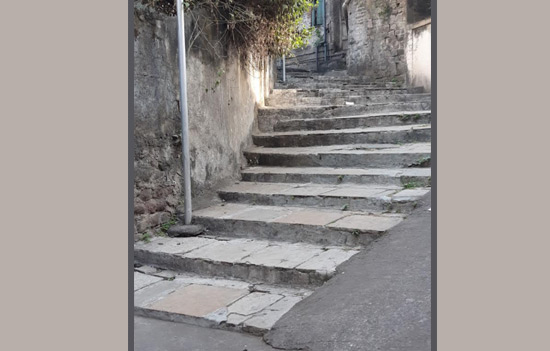 The steps that went to the Kokan Darwaza of the Old Kot once.
The steps that went to the Kokan Darwaza of the Old Kot once.Nothing remains of the Kille Hissar or the old Kot built by Bada Arab. Its vestiges in some forms are still visible. The steps aligned to one of the doorways–the 'Kokan Darwaza' still remain. These steps have been paved in modern times. However, historians say that the steps and alignment remains much the same. It is indeed thrilling to realise that that people in the earlier times, for hundreds of years may have walked this way. The steps also provide a cue in understanding the position and structure of the Old Kot.
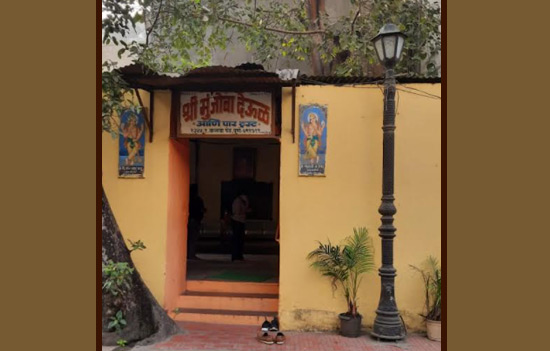 The Baloba Munja is believed to go back to the 15 century.
The Baloba Munja is believed to go back to the 15 century. Not too far
away from these steps is the small temple to the Baloba Munja. A folk deity in Maharashtra, Munja is generally
considered to be a spirit of a young boy. The Munja locations are generally at
trees, generally a pipal tree. It is believe that the Baloba Munja location goes
back many centuries and before the times of the Old Kot.
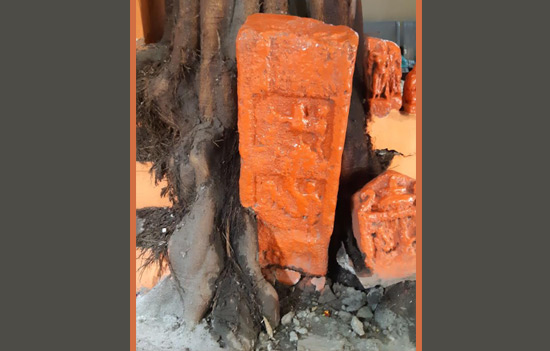 The 'Veer-Gal' or heroes stone at the temple.
The 'Veer-Gal' or heroes stone at the temple. There is also an ancient 'Veer Gal' or the hero's stone at the location. The 'Veer Gal' is a form of memorial to heroes from the region. This tradition of sculpted hero's stones can be seen in areas of Maharashtra and Karnataka.
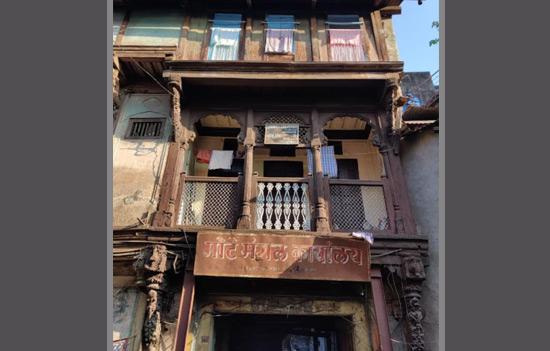 Beautiful wooden pillars and embellishments provide a glimpse to its earlier beauty.
Beautiful wooden pillars and embellishments provide a glimpse to its earlier beauty.The street behind the Baloba Munja temple was where the wada or residence of the Dixit Patwardhan family was located. This was a prominent family during the Peshwa rule as one of the leading money lenders. They were related to the Peshwa family through marriage of the daughter of Hari Balambhatt with Vishwasrao, the elder son of Nanasaheb who was also Nanasaheb's heir. Vishvasrao died in battle at the battle of Panipat in 1761. The Wada was converted into a Mangal Karyalay or venue for private functions like marriage in the early decades of the twentieth century. Its grandeur can be visualized from its facade and what remains.
The
Nilkantheshwar Temple in the lane opposite this wada has been renovated in
rather gaudy colours erasing much of the traditional feel. As per historical
records, it is one of the deity that was offered a Dakshina to celebrate the birth of Sawai Madhavrao Peshwa in 1774.
It was prominent enough to be offered a dakshina, hence it may have been there
for a long time before this. The Nilkantheshwar Temple also has an old Ganesh
Murti.
A few hundred
meters from this place is the Lal Mahal. It was here that the young Shivaji
Raje spent his childhood days. The character of a person is not built in a day
but is the result of values embodied over a period. Knowing that this place
played a part in building the impeccable character of Shivaji Maharaj is itself
the reason for its prominence.
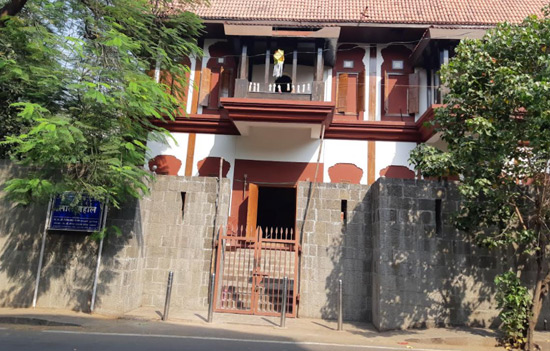 The formative years of childhood of Chhatrapati Shivaji Maharaj were spent at Lal Mahal.
The formative years of childhood of Chhatrapati Shivaji Maharaj were spent at Lal Mahal.The present Lal
Mahal is a modern structure that has been built in the past decades. However,
it stands at the location where the original Lal Mahal once stood. Shaista Khan
had captured Pune and was staying at the Lal Mahal in 1660. In one of the most dramatic
raids in history, Shivaji Maharaj attacked Shaista Khan here, in his camp at
the dead of night. Least expecting this attack the Khan who was sleeping was
caught unawares and he ran for his life. Though Shaista Khan fled successfully,
he lost his fingers at the hands of Shivaji Maharaj.
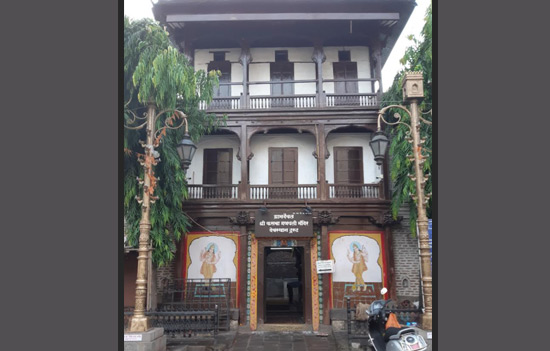 Entrance to the Shri Kasba Ganpati Mandir.
Entrance to the Shri Kasba Ganpati Mandir.Behind the Lal Mahal is the temple of Kasba Ganpati the 'Gram Daivat' or village deity of Pune. The Kasba Ganpati has a
prominent place in the social, cultural and religious spheres in the city. As
the Gram daivat the citizens of Pune visit the temple and first offer an
invitation for auspicious functions like marriages or thread ceremonies. It is
only when the Gram Daivat is offered
an invitation, are the invitations given to friends, relative and other
invitees.
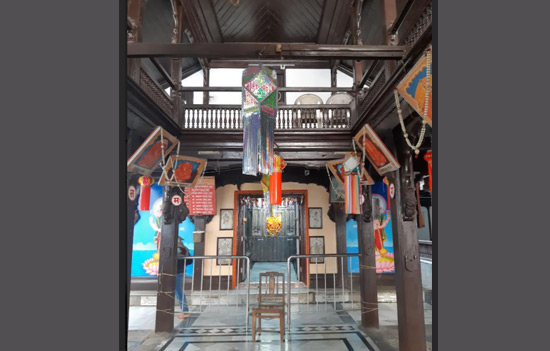 The Sabhamandap of the temple is wooden and the Garbha Griha built in stone.
The Sabhamandap of the temple is wooden and the Garbha Griha built in stone.The Kasba Ganpati Temple has an old wada facade. Inside the temple is a wooded 'sabha mandap' typical of the Peshwa Era. The antaral and the Garbha Griha or Gabhara is built in stone and the pillars are similar to the Yadav period architecture. It is believed that Jijabai the mother of Chhatrapati Shivaji helped rebuild this temple.
During Ganesh-uttsav i.e. celebrated in Pune on a grand scale, the Kasba Ganpati is offered a special privilege. At the time of the 'visrjan' procession the murti of the Kasba Ganpati Mandal leads all other Ganesh Mandals. This is a tradition that has continued for years since the times of Lokmanya Tilak.
The lane next
to the Kasba Ganpati once had the wada or mansion of Konher Trimbak Ekbote who
was recognised with the honorific–phakda
for his valour against Nizam Salabat Jung in 1751.
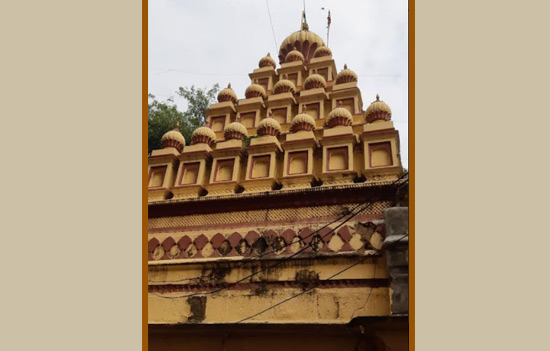 The honeycomb shikhara has hollows to place lamps.
The honeycomb shikhara has hollows to place lamps.At the end of
this very narrow lane is the temple of Kedareshwar. The deity is considered to
be one of the earliest deities in Pune. The present temple structure goes back
to the 1700s in the Peshwa Era. The Shikhara of the Kedareshwar temple looks
like a honey comb since the structure has provision to keep oil lamps in the
specially built konadas or hollows in the temple shikhara.
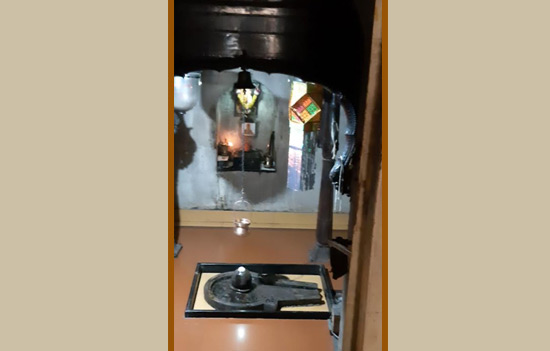 Kedareshwar Deity is considered to be one of the earliest in Pune
Kedareshwar Deity is considered to be one of the earliest in PuneThe deity is believed to be 700 years old. The city wall built around Pune in the 1500s had an entry gate or 'ves' called the Kedar
Ves named after the Kedareshwar Deity. The temple in addition to the
Kedarehwar Linga also has another Shiva Linga on its premises. This natural
Shiva Linga is pancha-mukhi or has
five faces.
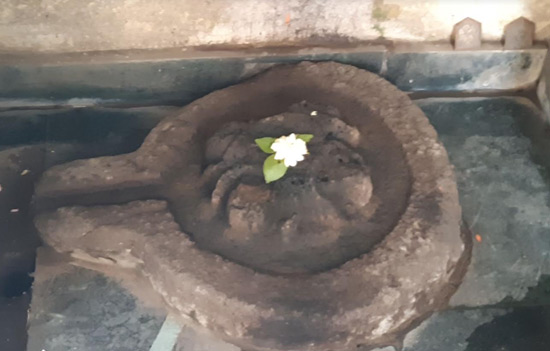 Panchamukhi Shiva Linga in the temple premises.
Panchamukhi Shiva Linga in the temple premises.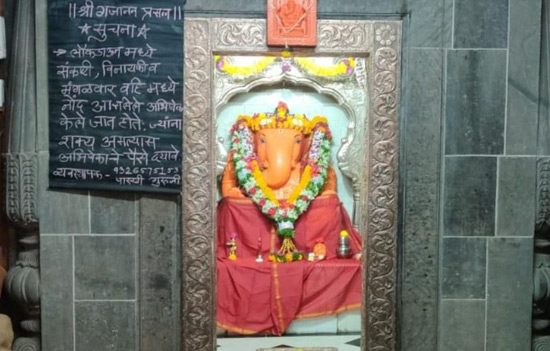 The beautiful murti at Gundacha Ganpati Temple.
The beautiful murti at Gundacha Ganpati Temple.The Gundacha
Ganpati is another well maintained temple in Kasba Peth. The Gundacha Ganpati
gets its name from the name of a person Nagoji
Gund whose house was located nearby. The deity is revered by many followers
who visit the temple regularly. The Ganpati has its trunk to the right side and
is thus considered quite powerful. The temple was restored quite aesthetically
and while staying true to the architectural style and ethos of the period. The
deity finds mention in records from the early 1800s.
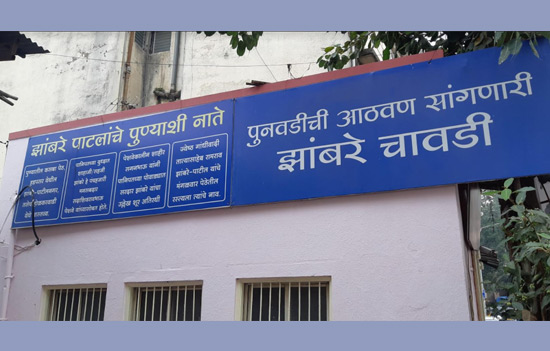 Zambre family were the village heads.
Zambre family were the village heads.Pune was a
small place in the 15th and 16th centuries. Like most villages of the period the village of Kasbe Pune had its Patil or village Head-Man coming from the Zambre Family. There are historical references to the Peshwa purchasing some land for the Shaniwar Wada expansion from the 'Zambda' family. It is possible that the record refer to the same Zambre clan. The family acquitted themselves well in the battle of Panipat fighting with Sadashivrao Bhau. The office building or 'Chavdi' of the Patil no longer exists. However, its memory is kept alive in the locality called Zambre Chawdi in Kasba Peth.
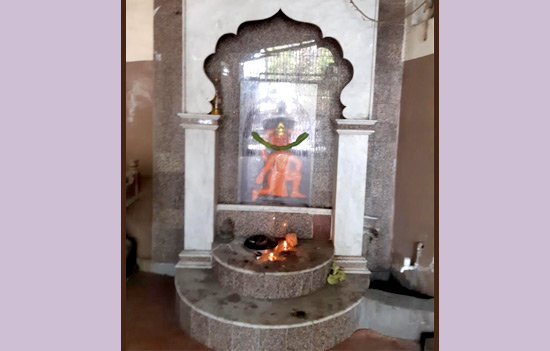 Gaokos Maruti once guarded the city wall.
Gaokos Maruti once guarded the city wall.Beyond the Zambre Chavdi is the Gaokos Maruti Temple. Gaokos refers to the city wall or 'kus' of the town. The city wall encircling Pune once existed at this point and the temple of Maruti at this city limits was thus called the Gao-Kos Maruti.
Nanasaheb
Peshwa is said to have rebuilt this section of the wall. The wall does not
exist today. However, there is evidence to point it once existed. The stone
plinth at a few places also point to the existence of the wall.
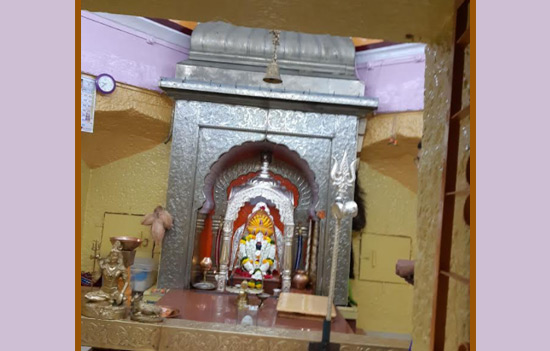 The Kal Bhairav is considered the 'Kshtra Pal' of the village.
The Kal Bhairav is considered the 'Kshtra Pal' of the village.A hundred
meters from the Zambre Chavdi and the Gaokos Maruti is the Kal-Bhairav Temple.
Most towns and villages in Maharashtra have a Kal-Bhairav Temple. The deity is
considered to the Kshetra Pal or the Deity in charge of the village.
From the
outside, the Kal-Bhairav Temple appears as a new structure. However, beyond the
new sabha-mandap the old structure becomes apparent. On the temple wall, at the
rear, is an engraved lotus. As per some students of Indian Architecture this
feature probably indicates that the temple may have been built in the Yadav
period.
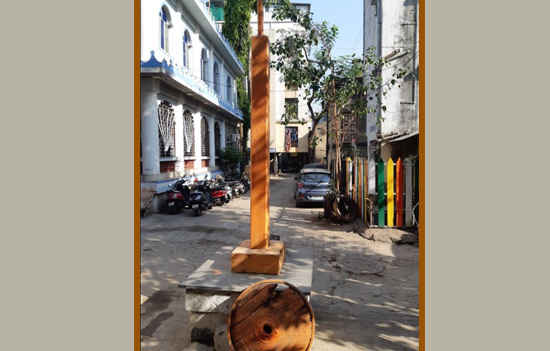 Bagad Pole. The ritual of Bagad still continues in a symbolic manner around this pole
Bagad Pole. The ritual of Bagad still continues in a symbolic manner around this poleOpposite the temple is a pole erected for the ritual of 'Bagaad'. The ritual is now performed in a symbolic manner only on 'Hanuman Jayanti' keeping in mind modern sensibilities. The actual ritual of Bagaad during historical times had people who voluntarily chose to be suspended high in mid-air and be revolved like a carousel around a central pole.
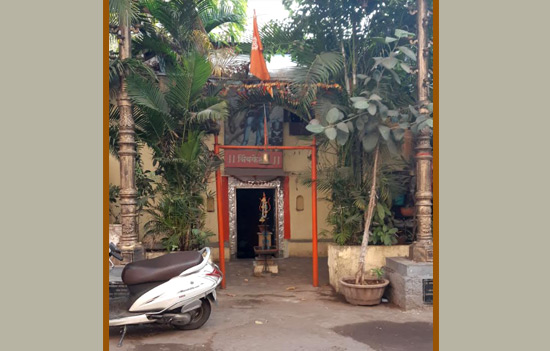 Trimbakeshwar Temple. A village feel in the bustling metropolis
Trimbakeshwar Temple. A village feel in the bustling metropolisThe
Trimbakeshwar Temple near the Kal-Bhairav Temple has a rustic, old world and
village look. It is indeed refreshing to see this simple and old structure in
the midst of a modern city like Pune. The temple is in the Vyavahar Ali or
Lane. The temple also has murti of Vitthal Rakhmai in the Garbha Griha. The Ganesh Patti that adorns the Garbha Griha
has a traditional Ganpati. The Trimbakeshwar Deity is also likely to be atleast
300 years old if not older and is in the oldest parts of Kasba Peth.
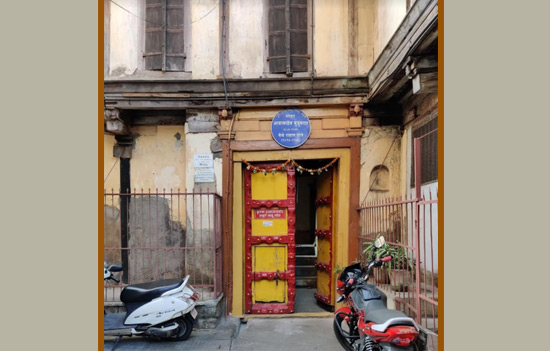 Wadas like these once dotted the Peths of Pune.
Wadas like these once dotted the Peths of Pune.The Kasba Peth
earlier had wadas or mansions of important people like the Shitole family who
were the Deshmukh of the region. Trimbakmama Pethe, an influential sardar
during the reign of the Peshwa, also had his mansion here. The Purandare Wada
was the residence of the Purandare Family that was close to the Peshwas over
generations. The Mujumdar Wada still stands as a reminder to the wadas of
earlier times.
The lanes in
Kasba Peth were often based on the traditional professionals of the people.
There is a Tambat Ali or lane of copper-smiths, Shimpi Ali or lane of tailors,
Bhoi Ali or lane of the fisher folk. Kasba was therefore a self-contained place
by itself. Even today Kasba Peth has families that have resided here over
generations. They have been instrumental in keeping alive the vibes that define
the Kasba Peth.
A lot has
changed in the city of Pune over the years. Old structures have given way to
heritage properties. The silver lining is that people once again are taking
interest in their heritage and their past. Walking through the Kasba Peth is
the best way to immerse oneself in this experience. The temples have been some
of the markers of the time gone by and have stood as witnesses from whom we can
learn about our culture and history.
Exploring the Kasba rejuvenates us and builds a bridge with our heritage. Kasba Peth indeed. Kasba Peth has embraced the present while retaining many historical landmarks.
If you are interested in doing this walk contact author at Sandeep_godbole@yahoo.com